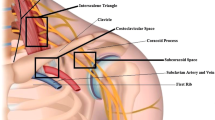Abstract
The story of the thoracic outlet compression syndrome begins with the identification of the anatomical abnormality of the cervical rib, and the symptoms related to it. Resection of the cervical rib, however, was soon followed by the recognition that symptoms could occur in the absence of a cervical rib. The scalenus anticus was then held to be the culprit, although several different mechanisms were advanced to explain the development of symptoms. Subsets of the thoracic outlet compression syndrome were then codified; costoclavicular compression; compression under the coracoid process during hyperabduction; primary symptoms related to arterial compression; and the syndrome that appears when neural and arterial compression are absent but venous occlusion is present. The importance of the first rib as a common denominator has brought about the idea that first rib resection is the best method of extirpating this common anatomic factor. That thesis is not accepted universally, however.
Similar content being viewed by others
References
ROB CG, STANDEVEN A. Arterial occlusion complicating thoracic outlet compression syndrome.Br Med J 1958;2: 709–712.
EDWARDS EA. Anatomic and clinical comments on shoulder girdle syndromes. In: BARKER WF (Ed). Surgical treatment of peripheral vascular disease. New York, Blakiston-McGraw Hill Book Company Inc., 1961, pp 111–131.
MURPHY JB. The clinical significance of cervical ribs.Surg Gynecol Obstet 1906;3:514–520.
HUNAULD. Sur le nombre des côtes, moindre ou plus grand quà l’ordinare. Hist Acad roy de sei de Paris, 1740.
WILLSHIRE.Lancet 1860;ii:633.
COOTE H. Exostosis of the left transverse process of the seventh cervical vertebra, surrounded by blood vessels and nerves; successful removal.Lancet 1861;i:360–361.
BRAMWELL E. Lesion of the first dorsal nerve root.Rev Neurol Psych 1903;1:236–239.
LAW AA. Adventitious ligaments simulating cervical ribs.Ann Surg 1920;72:497–499.
EISENDRATH DN. The existence of cervical ribs in man.Am Med 1904;8:322–325.
MURPHY JB. A case of cervical rib with symptoms resembling subclavian aneurysm.Ann Surg 1905;41:399–406.
HALSTED WS. An experimental study of circumscribed dilatation of an artery immediately distal to a partially occluding band and its bearing on the dilation of the subclavian artery observed in certain cases of cervical rib.J Exp Med 1916;24:271–286.
HOLMAN E. On circumscribed dilatation of an artery immediately distal to a partially occluding band: poststenotic dilatation.Surgery 1954;36:3–24.
WARREN JM. Ligature of the left subclavian artery for subclavian aneurysm; with a remarkable deviation of the vessel and consequent change of its relations.Am J Med Sei 1849;17:13–20.
ADSON AW, COFFEY JR. Cervical rib. A method of anterior approach for relief of symptoms by division of the scalenus anticus.Ann Surg 1927;85:839–857.
MACHLEDER HI. Vascular disorders of the upper extremity. Mount Kisco, NY, Futura Publishing Company, 1983, pp 91–106.
NAFFZIGER HC, GRANT WT. Neuritis of the brachial plexus mechanical in origin.Surg Gynecol Obstet 1938;67:722–730.
OCHSNER A, GAGE M, DEBAKEY M. Scalenus anticus (Naffziger) syndrome.Am J Surg 1935;28:669–693.
EDEN KC. Vascular complications of cervical ribs and first thoracic rib abnormalities.Br J Surg 1939;27:111–139.
WRIGHT IS. The neurovascular syndrome produced by hyperabduction of the arms.Am Heart J 1945;29:1–19.
FALCONER MA, LI FWP. Resection of first rib in costoclavicular compression of brachial plexus.Lancet 1962;i:59–63.
CLAGETT OT. Presidential address: research and prosearch.J Thorac Cardiovasc Surg 1962;44:153–166.
ROOS DB. Transaxillary approach for first rib resection to relieve thoracic outlet obstruction.Ann Surg 1966;163:354–358.
SANDERS RJ, MONSOUR JW, GERBER WF. Scalenectomy versus first rib resection for treatment of thoracic outlet syndrome.Surgery 1979;85:109–121.
DOS SANTOS JC. Sur la désobstruction des thromboses artérielles anciennes.Mém Acad Chir 1947;73:407–411.
BANIS Jr JC, RICH NM, WHELAN TC. Ischemia of the upper extremity due to noncardiac emboli.Am J Surg 1977;134:131–139.
McLEERV RS, KESTERSON JE, KIRTLEY JA, LOVE RB. Subclavius and anterior scalene muscle compression as a cause of intermittent obstruction of the subclavian vein.Ann Surg 1951;133:588–602.
MACHLEDER HI, MOLL F, VERITY MA. The anterior scalene muscle in thoracic outlet compression syndrome. Histochemical and morphometric studies.Arch Surg 1986;121:1141–1144.
REILLY LM, STONEY RJ. Supraclavicular approach for thoracic outlet decompression.J Vase Surg 1988;8:329–334.
Author information
Authors and Affiliations
About this article
Cite this article
Barker, W.F. An historical look at the thoracic outlet compression syndrome. Annals of Vascular Surgery 3, 293–298 (1989). https://doi.org/10.1007/BF03187412
Issue Date:
DOI: https://doi.org/10.1007/BF03187412




